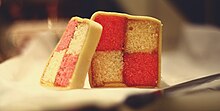Battenberg cake
The Battenberg cake (also domino cake ) is a sponge cake that is made from an undyed and mostly pink-colored sponge stick with a square cross-section so that the cake shows its characteristic checkerboard pattern after cutting . The cake is coated with a thin layer of marzipan . A sponge cake colored with cocoa can be used instead of the pink colored bars. The sponge sticks are held together by apricot jam.
Sometimes Battenberg cake is also made with (3x3 =) 9 strands. The Battenberg cake is very popular in the UK.
A similar cake is in the US "checkerboard cake" (German: checkerboard cake ) called.
Emergence
The origin is unclear and there is probably no written record. However, it is generally believed that the cake was created in 1884 on the occasion of the wedding of Princess Viktoria (Queen Victoria's granddaughter ) to Prince Ludwig Alexander von Battenberg . The four squares are said to represent the four princes of the Battenbergs: Ludwig Alexander, Alexander , Heinrich and Franz Joseph .
Prince Ludwig Alexander went to Great Britain , was naturalized as a British subject and has called himself "Prince Louis of Battenberg" since then. In 1917 he renounced all German titles and adopted the English translation "Mountbatten" as the name. Princess Viktoria and Louis Mountbatten were the grandparents of Prince Philip , Prince Consort of Queen Elizabeth II of Great Britain .
The noble family was named after the Hessian city of Battenberg .
The cake has also given its name to the Battenberg mark .
Individual evidence
- ↑ Production of a Battenberg cake in individual steps
- ^ Minor British Institutions: Battenberg cake
- ^ Food History Jottings: Battenburg Cake - the Truth
